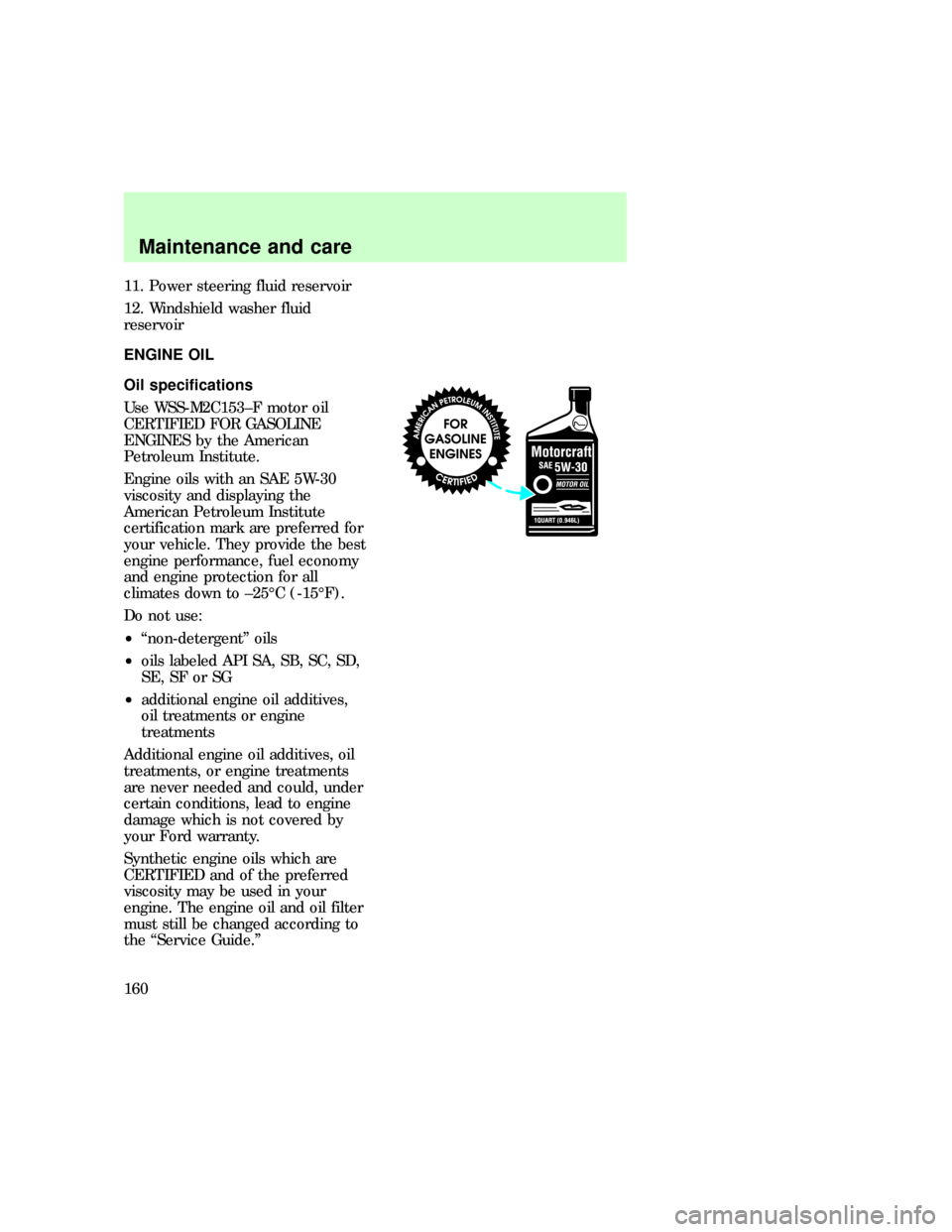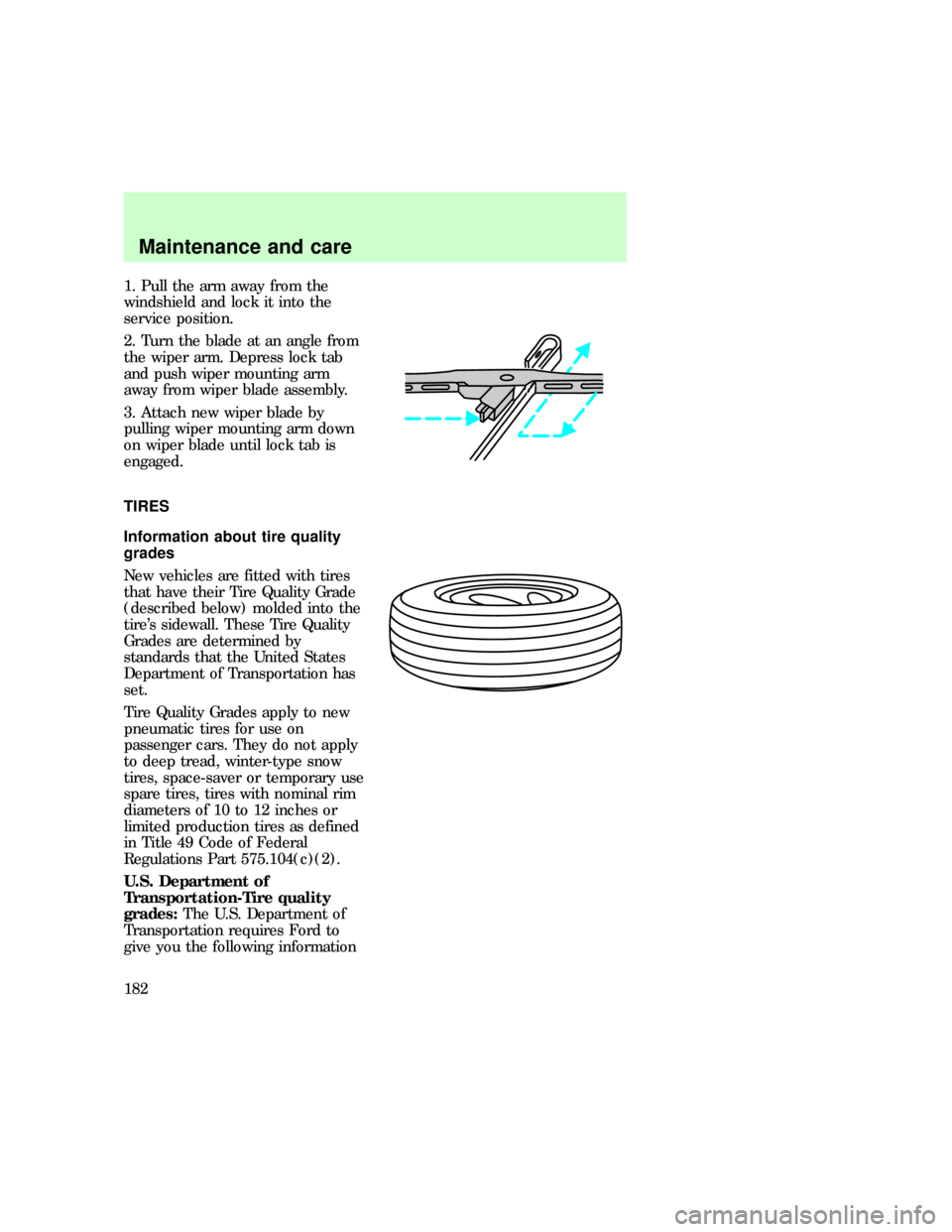Page 159 of 219

11. Power steering fluid reservoir
12. Windshield washer fluid
reservoir
ENGINE OIL
Oil specifications
Use WSS-M2C153±F motor oil
CERTIFIED FOR GASOLINE
ENGINES by the American
Petroleum Institute.
Engine oils with an SAE 5W-30
viscosity and displaying the
American Petroleum Institute
certification mark are preferred for
your vehicle. They provide the best
engine performance, fuel economy
and engine protection for all
climates down to ±25ÉC (-15ÉF).
Do not use:
²ªnon-detergentº oils
²oils labeled API SA, SB, SC, SD,
SE, SF or SG
²additional engine oil additives,
oil treatments or engine
treatments
Additional engine oil additives, oil
treatments, or engine treatments
are never needed and could, under
certain conditions, lead to engine
damage which is not covered by
your Ford warranty.
Synthetic engine oils which are
CERTIFIED and of the preferred
viscosity may be used in your
engine. The engine oil and oil filter
must still be changed according to
the ªService Guide.º
f12_engine_oil
f12_oil_specs
Maintenance and care
160
Page 160 of 219

Oil filters
Ford production and aftermarket
(Motorcraft) oil filters are designed
for added engine protection and
long life. If a replacement oil filter
is used that does not meet Ford
material and design specifications,
startup engine noises or knock
may be experienced. It is
recommended that you use the
appropriate Motorcraft oil filter (or
another brand meeting Ford
specifications) for your engine
application.
Checking engine oil
Check the engine oil each time you
fuel your vehicle.
Check the engine oil level more
frequently if the vehicle is carrying
a heavy load, towing a trailer,
idling for extended periods (like
police, taxi or shuttle service
vehicles) or driven at high speeds
for extended periods of time.
To check the oil:
1. Make sure the vehicle is on level
ground. If the engine is warm, turn
the engine off and wait a few
minutes for the oil to drain into
the oil pan.
2. Set the parking brake and
ensure the gearshift is latched in P
(Park) (automatic transmission) or
1 (First) (manual transmission).
3. Open the hood. Protect yourself
from engine heat.
4. Locate and carefully remove the
f12_checking_oil
Maintenance and care
161
Page 162 of 219
the MAX line, engine damage or
high oil consumption may occur
and some oil must be removed
from the engine by a service
technician.
7. Put the dipstick back in and
ensure it is fully seated.
Adding engine oil
1. Check the engine oil.
2. If the oil level is below the MIN
line, then add engine oil.
3. Remove the yellow oil filler cap.
4. Use a funnel to add oil through
the opening.
Make sure you use a certified
engine oil of the preferred
viscosity.
5. Recheck the oil level. Make sure
that the oil level is not above the
MAX line on the dipstick.
Continuous contact with
usedmotor oil has caused
cancer in laboratory mice.
f12_adding_oil
f12_brake_fluid
Maintenance and care
163
Page 170 of 219

cooling mode. If the engine coolant
supply is depleted, this feature
allows the driver to drive the
vehicle (with limited power) for a
short distance in order to get the
vehicle to a service facility. Take
your vehicle to a service facility as
soon as possible to minimize
engine damage.
The actual distance your vehicle
can be driven depends on vehicle
load, road conditions and outside
temperature.
How fail-safe cooling works
If the engine overheats, the engine
will automatically switch from
eight to alternating four cylinder
operation. Each disabled cylinder
acts as an air pump and cools the
engine.
When this occurs, the engine
coolant temperature gauge will
move into the red area and the
light illuminates.
The
CHECK
ENGINElight will illuminate,
indicating that vehicle service is
required.
The vehicle will still operate, but
will have limited engine power and
no air conditioning capability.
Continued operation will increase
engine temperature and cause the
engine to completely shut down.
The vehicle will coast to a stop.
As the engine temperature cools,
the engine may be re-started. Take
your vehicle to a service facility as
CHCH
Maintenance and care
171
Page 172 of 219
2. When the engine coolant
temperature gauge reaches the
normal zone, turn the engine off.
3. Visually inspect the fluid level in
the power steering fluid reservoir.
4. Add power steering fluid until
the fluid level reaches MAX.
Use only fluid that meets Ford
specifications. Refer toCapacities
and specifications.
CHECKING AND ADDING
TRANSMISSION FLUID
Checking and adding automatic
transmission fluid (if equipped)
Service the automatic transmission
according to the scheduled
intervals in the ªService Guide.º
MAX
MIN
MAX
MIN
f12_trans_fluid
f12_checking_adding_autotrans
Maintenance and care
173
Page 181 of 219

1. Pull the arm away from the
windshield and lock it into the
service position.
2. Turn the blade at an angle from
the wiper arm. Depress lock tab
and push wiper mounting arm
away from wiper blade assembly.
3. Attach new wiper blade by
pulling wiper mounting arm down
on wiper blade until lock tab is
engaged.
TIRES
Information about tire quality
grades
New vehicles are fitted with tires
that have their Tire Quality Grade
(described below) molded into the
tire's sidewall. These Tire Quality
Grades are determined by
standards that the United States
Department of Transportation has
set.
Tire Quality Grades apply to new
pneumatic tires for use on
passenger cars. They do not apply
to deep tread, winter-type snow
tires, space-saver or temporary use
spare tires, tires with nominal rim
diameters of 10 to 12 inches or
limited production tires as defined
in Title 49 Code of Federal
Regulations Part 575.104(c)(2).
U.S. Department of
Transportation-Tire quality
grades:The U.S. Department of
Transportation requires Ford to
give you the following information
f12_maint_tires
com_about_tire_grades.01
Maintenance and care
182
Page 182 of 219

about tire grades exactly as the
government has written it.
Treadwear
The treadwear grade is a
comparative rating based on the
wear rate of the tire when tested
under controlled conditions on a
specified government test course.
For example, a tire grade 150
would wear one and one-half (1
1/2) times as well on the
government course as a tire grade
100. The relative performance of
tires depends upon the actual
conditions of their use, however,
and may depart significantly from
the norm due to variations in
driving habits, service practices,
and differences in road
characteristics and climate.
Traction A B C
The traction grades, from highest
to lowest are A, B, and C, and they
represent the tire's ability to stop
on wet pavement as measured
under test surfaces of asphalt and
concrete. A tire marked C may
have poor traction performance.
Warning: The traction grade
assigned to this tire is based on
braking (straightahead) traction
tests and does not include
cornering (turning) traction.
Temperature A B C
The temperature grades are A (the
highest), B, and C, representing
the tire's resistance to the
generation of heat and its ability to
dissipate heat when tested under
com_treadwear.01
com_traction_abc.01
com_temperature_abc.01
Maintenance and care
183
Page 184 of 219
hour or driven less than 5 km [3
miles]).
The cold pressure amount is listed
on the Safety Compliance
Certification Label located on the
inside driver door latch pillar.
Improperly inflated tires
can affect vehicle handling
and can fail suddenly, possibly
resulting in loss of vehicle
control.
Rotating the tires
Rotate your tires at regular
intervals to ensure even wear.
Refer to the following diagrams for
rotation cycles. Rotation intervals
are listed in the ªService Guide.º
Your wheels and tires are
match-mounted for improved ride.
Before you begin a tire repair,
mark the wheel and tire to ensure
f12_rotating_tires
Maintenance and care
185